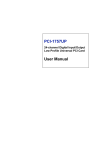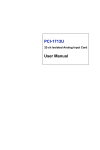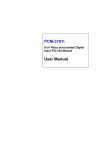Download Advantech PCI-1757UP Specifications
Transcript
Copyright This documentation and the software included with this product are copyrighted 2003 by Advantech Co., Ltd. All rights are reserved. Advantech Co., Ltd. reserves the right to make improvements in the products described in this manual at any time without notice. No part of this manual may be reproduced, copied, translated or transmitted in any form or by any means without the prior written permission of Advantech Co., Ltd. Information provided in this manual is intended to be accurate and reliable. However, Advantech Co., Ltd. assumes no responsibility for its use, nor for any infringements of the rights of third parties which may result from its use. Acknowledgments PC-LabCard is a trademark of Advantech Co., Ltd. IBM and PC are trademarks of International Business Machines Corporation. MS-DOS and Windows are trademarks of Microsoft Corporation. Intel and Pentium are trademarks of Intel Corporation. CE notification The PCI-1757UP, developed by ADVANTECH CO., LTD., has passed the CE test for environmental specifications when shielded cables are used for external wiring. We recommend the use of shielded cables. This kind of cable is available from Advantech. Please contact your local supplier for ordering information. Part No. 2003175700 Printed in Taiwan 1st Edition August 2003 Contents Chapter 1 General Information..................................................1 1.1 Introduction .................................................................................................3 Chapter 2 Installation................................................................7 2.1 Initial Inspection.........................................................................................9 2.2 Unpacking....................................................................................................9 2.3 Jumper & Switch Settings.......................................................................10 2.4 Pin Assignments .......................................................................................13 2.5 Installation Instructions ...........................................................................14 Chapter 3 Operation................................................................ 15 3.1 Operation....................................................................................................17 3.2 Digital I/O Ports........................................................................................17 3.3 Interrupt Function.....................................................................................19 Appendix A Register Format................................................... 23 A.1 Register Format of PCI-1757UP...........................................................25 Chapter 1 General Information 2 PCI-1757UP User's Manual 1.1 Introduction The PCI-1757UP is a 24-bit DI/O card with PCI bus. It provides you with 24 bits of parallel digital input/output, and emulates mode 0 of the 8255 PPI chip, but the buffered circuits offer a higher driving capability than the 8255. The card emulates one 8255 PPI chips to provide 24 DI/O bits. The I/O bits are divided into three 8-bit I/O ports: A0, B0 and C0. You can configure each port as either input or output via software. The dual interrupt handling capability provides users the flexibility to generate interrupts to a PC. A pin in the connector can output a digital signal simultaneously with the card's generating an interrupt. This card uses a DB 25-pin connector for easy and reliable connections to field devices. One feature gives the PCI-1757UP practical advantage in an industrial setting. When the system is hot reset (the power is not turned off) the PCI-1757UP retains the last I/O port settings and output values if the user has set jumper JP1 to enable this feature. Otherwise, port settings and output values reset to their safe default state, or to the state determined by other jumper settings. Numbering Convention All numbers given in this manual are in decimal format unless specifically noted otherwise. In particular, where a register address is given as (Base + 32), the decimal number "32" should be added to the base value. Chapter 1 General Information 3 Features i Low profile PCI card i Universal PCI card, adapt 3.3V and 5V PCI slot i 24 TTL level digital I/O lines i Emulates mode 0 of 8255 PPI i Buffered circuits provide higher driving capability i Output status read-back i I/O configure by software or on board DIP switch i Keeps port I/O settings and digital output states after hot reset i Board ID set by DIP switch i Digital input with Interrupt capability i D-SUB 25-pin connector Specifications Digital Input • Logic high voltage: 2.0 V min. • Logic low voltage: 0.80 V max. • Maximum Input Leakage Current: 2µA Digital Output • Logic high voltage: 3.7 V min. @ 24mA (source) • Logic low voltage: 0.5 V max. @ -24 mA (sink) Interrupt Source • PC0, PC4 4 PCI-1757UP User's Manual General Connector: One D-SUB 25-p in female connector Power consumption: 5 V @ 200 mA (Typical) Operating temperature: 0 ~ 70º C (32º F ~ 158 ºF) Storage temperature: -20 ~ 80º C (-4º F ~ 176º F) Humidity: 5% ~ 95% non-condensing Dimension: 119.91 x 64.41 mm (4.721" x 2.536") Low profile PCI MD1 card size. I/O channels: 48 digital I/O lines Programming mode: 8255 PPI mode 0 Chapter 1 General Information 5 6 PCI-1757UP User's Manual Chapter 2 Installation 8 PCI-1757UP User's Manual 2.1 Initial Inspection Before starting to install the PCI-1757UP, make sure there is no visible damage on the card. We carefully inspected the card both mechanically and electrically before shipment. It should be free of marks and in perfect order on receipt. As you unpack the PCI-1757UP, check it for signs of shipping damage (damaged box, scratches, dents, etc.) If it is damaged or fails to meet its specifications, notify our service department or your local sales representative immediately. Also, call the carrier immediately and retain the shipping carton and packing materials fo r inspection by the carrier. We will then make arrangements to repair or replace the unit. 2.2 Unpacking The PCI-1757UP contains components that are sensitive and vulnerable to static electricity. Discharge any static electricity on your body to ground by touching the back of the system unit (grounded metal) before you touch the board. Remove the PCI-1757UP card from its protective packaging by grasping the card's rear panel. Handle the card only by its edges to avoid static discharge which could damage its integrated circuits. Keep the antistatic package. Whenever you remove the card from the PC, please store the card in this package for its protection. You should also avoid contact with materials that hold static electricity such as plastic, vinyl and styrofoam. Check the product contents inside the packing. There should be one card, one CD-ROM, and this manual. Make sure nothing is missing. Chapter 2 Installation 9 2.3 Jumper & Switch Settings We designed the PCI-1757UP with ease-of-use in mind. It is a "plug and play" card, i.e. the system BIOS assigns the system resources such as base address and interrupt automatically. The following section describes how to configure the card. You may want to refer to the figure below for help in identifying card components. Figure 2-1: Location of connectors and jumpers Setting to Broad ID (SW1) This section describes how to set the Broad ID of PCI -1757UP. The figure and table below show the switch locations and setting how to set Board ID. 10 PCI-1757UP User's Manual SW1 Position1 Position2 Position3 Position4 Board ID 0* 1 2 : 14 15 ID3 n n n : o o ID2 n n n : o o ID1 n n o : o o ID0 n o n : n o Table 2-1: Board ID Note: n : ON; o : OFF * Default setting is 0. Set Ports as Input or Output (SW2) Description IO CF. PA PCL PB PCH Switch 2 SW2-1 SW2-2 SW2-3 SW2-4 SW2-5 SW2-6 ON HW IN IN IN IN OFF SW OUT OUT OUT OUT *Default setting is all positions off. Table 2-2: Input or Output Ports Setting The PCI-1757UP emulates one 8255 programmable peripheral interface (PPI) chips in mode 0, but with higher driving capability than a standard Chapter 2 Installation 11 8255 chip. Each of the 8255 chips has 24 programmable I/O pins that are divided into two 8-bit ports and two 4-bit ports, designated PA, PB PCL and PCH. Each port can be programmed as an input or an output port. User can set the corresponding ports to be configurable as input or output ports by switch SW2 or software. When “IO CF.” position is “ON”, user can set the ports to be input or output ports by the software. Else, when “IO CF.” position is “Off”, user can set the ports by the switch SW2 directly. The position setting is “ON”, the corresponding port is input port; else position is “OFF”, the corresponding port is output port. Hot reset setting (JP1) To see the table below, User can use the JP1 to set the hot reset type of PCI-1757UP. PCI-1757UP JP1 Power on configuration after hot reset Keep the I/O configuration while hot reset. Clear the I/O configuration to default while hot reset. Default setting is lower (1, 2) position. Table 2-3: Hot reset mode setting 12 PCI-1757UP User's Manual If the jumper JP1 is at lower (1, 2) position and the initial configuration is caused by a reset, all ports will return to the states they had just prior to the reset. The reset must be a "hot" reset (power not disconnected) for enabled JP1 to return ports to their prior values. Otherwise, the card behaves as though JP1 were not enabled. 2.4 Pin Assignments Description of pin use: Mode PA0 ~ PA7 PB0 ~ PB7 PC0 ~ PC7 GND Description I/O pins of Port A I/O pins of Port B I/O pins of Port C Ground Pin Pin 1~8 Pin 9~16 Pin 17~24 Pin 25 Chapter 2 Installation 13 2.5 Installation Instructions The PCI-1757UP can be installed in any PCI slot in the computer. However, refer to the computer user's manual to avoid any mistakes and danger before you follow the installation procedure below: 1. Turn off your computer and any accessories connected to the computer. Warning! TURN OFF your computer power supply whenever you install or remove any card, or connect and disconnect cables. 2. Disconnect the power cord and any other cables from the back of the computer. 3. Remove the cover of the computer. 4. Select an empty PCI slot. Remove the screw that secures the expansion slot cover to the system unit. Save the screw to secure the interface card retaining bracket. 5. Carefully grasp the upper edge of the PCI-1757UP. Align the hole in the retaining bracket with the hole on the expansion slot and align the gold striped edge connector with the expansion slot socket. Press the card into the socket gently but firmly. Make sure the card fits the slot tightly. 6. Secure the PCI-1757UP by screwing the mounting bracket to the back panel of computer. 7. Attach any accessories (25-pin cable, wiring terminal, etc.) to the card. 8. Replace the cover of your computer. Connect the cables you removed in step 2. 9. Turn the computer power on. 14 PCI-1757UP User's Manual Chapter 3 Operation 16 PCI-1757UP User's Manual 3.1 Overview This chapter describes the operating characteristics of the PCI-1757UP. The driver software provided allows a user to access all of the card's functions without register level programming. Please see the User's Manual for the driver bundled with this card for more information. For users who prefer to implement their own bit-level programming to drive the card's functions, information useful for making such a program is included in this chapter. 3.2 Digital I/O Ports Introduction The PCI-1757UP emulates one 8255 programmable peripheral interface (PPI) chips in mode 0, but with higher driving capability than a standard 8255 chip. Each of the 8255 chips has 24 programmable I/O pins that are divided into three 8-bit ports, designated PA, PB and PC. Each port can be programmed as an input or an output port. The I/O pins in port A are designated PA0, PA1,..., PA7; the pins in port B are designated PB0, PB1,..., PB7, etc. These port names are used both in this manual and in the software library. Refer to Section 2.4, Pin Assignments. 8255 Mode 0 The basic functions of 8255 mode 0 include: • Two 8-bit I/O ports - port A (PA) and port B (PB) • Port C is divided into two nibble -wide (4-bit) I/O ports: PC upper and PC lower • Any port can be used for either input or output. Chapter 3 Function Description 17 • Output status can be read back. Input/Output Control A control word can be written to a port's configuration register (Base+3) to set the port as an input or an output port, unless the ports are sets via the switch. Table 3-1 shows the format of a control word. Bit D0 D1 D2 D3 D4 D5 D6 D7 Description Port C lower bits 0: output; Port B 0: output; Don't care Port C higher bits 0: output; Port A 0: output; Don't care Don't care HW/SW 0: SW; 1: input 1: input 1: input 1: input 1: HW Table 3-1: Bit map of port configuration register Note: A control word has no effect if the corresponding port is set as an output port by the SMD switch SW2. D7 is a read only bit for identifying the SMD switch SW2 position 1 is ON or OFF. D7 = 0 means the I/O configuration is set by configuration register (SW); D7 = 1 means the I/O configuration is set by SMD switch SW2 (HW). When D7= 1, read the value of D4, D3, D1 and D0 mapping the SW2 location 3,4,5 and 6, respectively. Warning! Before setting any port as an output port via software, make sure that a safe output value has also been set. An output voltage will appear at the pins immediately following the control word taking effect. If no output value was specified, the value will be indeterminate (either 0 or 1), which may cause a dangerous condition. 18 PCI-1757UP User's Manual Initial Configuration The initial configuration of each port depends on the software or switch SW2 setting of each port as input or output port, on the setting of the jumper JP1 to set the hot reset type. 3.3 Interrupt Function Interrupt Function of the DIO Signals Two I/O pins (PC0 and PC1) can be used to generate hardware interrupts. A user can program the interrupt control register (Base + 32) to select the interrupt sources. The "Interrupt Control Register" (Base + 32) controls the interrupt signal source, edge and flag. Table 3-2 shows the bit map of the interrupt control register. The register is a readable/writable register. When writing to it, it is used as a control register, and when reading from it, it is used as a status register. Bit# D7 D6 D5 D4 D3 D2 D1 D0 X X X X F E M1 M0 Table 3-2: Interrupt control register bit map M0 and M1: "mode bits" of port 0 E: triggering edge control bits F: flag bits X: don’t care Chapter 3 Function Description 19 Interrupt Source Control The "mode bits" in the interrupt control register determine the allowable sources of signals generating an interrupt. Bit 0 and bit 1 determine the interrupt source, as indicated in Figure 3-1. Table 3-3 shows the relationship between an interrupt source and the values in the mode bits. M1:M0 00 PC0 01 VCC D Q INT CLK 10 CLR PC4 11 CLEAR INT Figure 3-1: Interrupt sources M1 0 0 1 1 M0 0 1 0 1 Description Disable interrupt Source = PC00 Source = PC00 & PC04 No used Table3-3: Interrupt mode bit values Interrupt Triggering Edge Control The interrupt can be triggered by a rising edge or a falling edge of the interrupt signal, selectable by the value written in the "triggering edge control" bit in the interrupt control register, as shown in Table 3-4. 20 PCI-1757UP User's Manual E 1 0 Triggering edge of interrupt signal Rising edge trigger Falling edge trigger Table 3-4: Triggering edge control bit values Interrupt Flag Bit The "interrupt flag" bit is a flag indicating the status of an interrupt. It is a readable and writable bit. Read the bit value to find the status of the interrupt, write "1" to this bit to clear the interrupt. This bit must be cleared in the ISR to service the next incoming interrupt. F Read Write 1 0 1 0 Interrupt status Interrupt occurred No interrupt Clear interrupt Don't care Table 3-5: Interrupt flag bit values Board ID Read Base +36 can get the board ID. The PCI-1757UP has a built-in SMD switch (SW1), which is used to define each card’s board ID. You can determine the board ID on the register as shown on Table 7. When there are multiple cards on the same chassis, this board ID setting function is useful for identifying each card’s device number through board ID. We set the PCI-1757UP board ID as 0 at the factory. If you need to adjust it to other board ID, set the SW1 by referring to the jumper and SMD switch setting. Chapter 3 Function Description 21 Bit# D7 D6 D5 D4 D3 D2 D1 D0 X X X X ID3 ID2 ID1 ID0 Table 3-6: Board ID register ID0: the least significant bit (LSB) of Board ID ID3: the most significant bit (MSB) of Board ID X: don’t care 22 PCI-1757UP User's Manual APPENDIX A Register Format 24 PCI-1757UP User's Manual A.1 Register Format of PCI-1757UP Base Address + Function n (Decimal) Read Write 0 Port A Port A 1 Port B Port B 2 Port C Port C 3 Configuration Register Configuration Register : : : 32 Interrupt Status Interrupt Control Register Register Board ID N/A 36 Chapter 3 Function Description 25







































